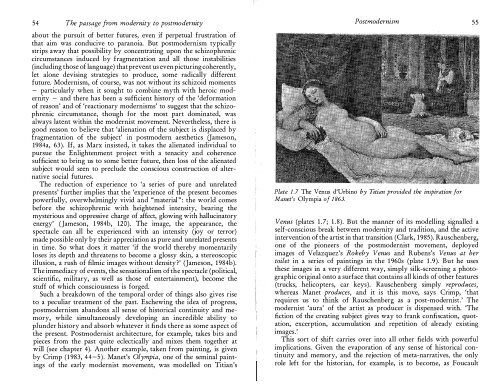The Condition of Postmodernity 13 - autonomous learning
The Condition of Postmodernity 13 - autonomous learning
The Condition of Postmodernity 13 - autonomous learning
Create successful ePaper yourself
Turn your PDF publications into a flip-book with our unique Google optimized e-Paper software.
54<strong>The</strong> passage from modernity to postmodernityabout the pursuit <strong>of</strong> better futures, even if perpetual frustration <strong>of</strong>that aim was conducive to paranoia. But postmodernism typicallystrips away that possibility by concentrating upon the schizophreniccircumstances induced by fragmentation and all those instabilities(including those <strong>of</strong> language) that prevent us even picturing coherently,let alone devising strategies to produce, some radically differentfuture. Modernism, <strong>of</strong> course, was not without its schizoid moments- particularly when it sought to combine myth with heroic modernity- and there has been a sufficient history <strong>of</strong> the 'deformation<strong>of</strong> reason' and <strong>of</strong> 'reactionary modernisms' to suggest that the schizophreniccircumstance, though for the most part dominated, wasalways latent within the modernist movement. Nevertheless, there isgood reason to believe that 'alienation <strong>of</strong> the subject is displaced byfragmentation <strong>of</strong> the subject' in postmodern aesthetics a ameson,1984a, 63). If, as Marx insisted, it takes the alienated individual topursue the Enlightenment project with a tenacity and coherencesufficient to bring us to some better future, then loss <strong>of</strong> the alienatedsubject would seen to preclude the conscious construction <strong>of</strong> alternativesocial futures.<strong>The</strong> reduction <strong>of</strong> experience to 'a series <strong>of</strong> pure and unrelatedpresents' further implies that the 'experience <strong>of</strong> the present becomespowerfully, overwhelmingly vivid and "material": the world comesbefore the schizophrenic with heightened intensity, bearing themysterious and oppressive charge <strong>of</strong> affect, glowing with hallucinatoryenergy' (Jameson, 1984b, 120). <strong>The</strong> image, the appearance, thespectacle can all be experienced with an intensity (joy or terror)made possible only by their appreciation as pure and unrelated presentsin time. So what does it matter 'if the world thereby momentarilyloses its depth and threatens to become a glossy skin, a stereoscopicillusion, a rush <strong>of</strong> filmic images without density?' (Jameson, 1984b).<strong>The</strong> immediacy <strong>of</strong> events, the sensationalism <strong>of</strong> the spectacle (political,scientific, military, as well as those <strong>of</strong> entertainment), become thestuff <strong>of</strong> which consciousness is forged.Such a breakdown <strong>of</strong> the temporal order <strong>of</strong> things also gives riseto a peculiar treatment <strong>of</strong> the past. Eschewing the idea <strong>of</strong> progress,postmodernism abandons all sense <strong>of</strong> historical continuity and memory,while simultaneously developing an incredible ability toplunder history and absorb whatever it finds there as some aspect <strong>of</strong>the present. Postmodernist architecture, for example, takes bits andpieces from the past quite eclectically and mixes them together atwill (see chapter 4). Another example, taken from painting, is givenby Crimp (1983, 44-5). Manet's Olympia, one <strong>of</strong> the seminal paintings<strong>of</strong> the early modernist movement, was modelled on Titian'sPostmodernismPlate 1.7 <strong>The</strong> Venus d'Urbino by Titian provided the inspiration forManet's Olympia <strong>of</strong> 1863.Venus (plates 1.7; 1.8). But the manner <strong>of</strong> its modelling signalled aself-conscious break between modernity and tradition, and the activeintervention <strong>of</strong> the artist in that transition (Clark, 1985). Rauschenberg,one <strong>of</strong> the pioneers <strong>of</strong> the postmodernist movement, deployedimages <strong>of</strong> Velazquez's Rokeby Venus and Rubens's Venus at hertoilet in a series <strong>of</strong> paintings in the 1960s (plate 1.9). But he usesthese images in a very different way, simply silk-screening a photographicoriginal onto a surface that contains all kinds <strong>of</strong> other features(trucks, helicopters, car keys). Rauschenberg simply reproduces,whereas Manet produces, and it is this move, says Crimp, 'thatrequires us to think <strong>of</strong> Rauschenberg as a post-modernist.' <strong>The</strong>modernist 'aura' <strong>of</strong> the artist as producer is dispensed with. '<strong>The</strong>fiction <strong>of</strong> the creating subject gives way to frank confiscation, quotation,excerption, accumulation and repetition <strong>of</strong> already existingimages.'This sort <strong>of</strong> shift carries over into all other fields with powerfulimplications. Given the evaporation <strong>of</strong> any sense <strong>of</strong> historical continuityand memory, and the rejection <strong>of</strong> meta-narratives, the onlyrole left for the historian, for example, is to become, as Foucault55
















